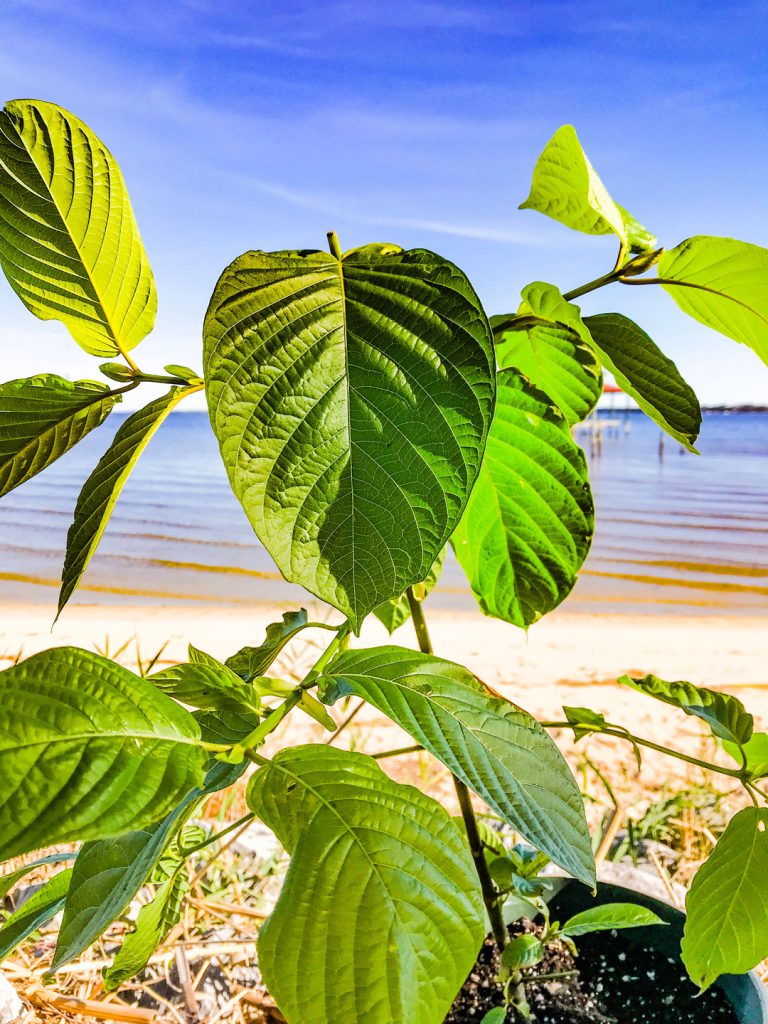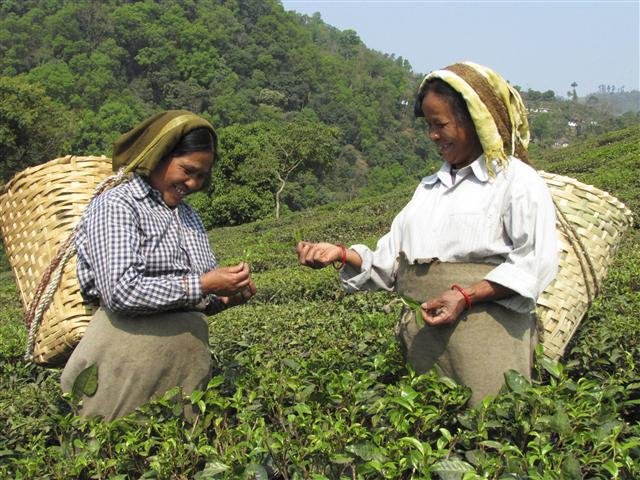Kratom
Kratom is a medicinal tree belonging to the Rubiaceae family, the same family of plants as coffee, and the use of its leaves has a long history due to its powerful stimulant and narcotic properties, due to mitragine, its main active ingredient.
It grows in Southeast Asia, mainly in Thailand and Malaysia. Its traditional use of this plant dates back many centuries and has its origins in Thailand.

What is kratom? (Mitragyna speciosa Korth)
Kratom (Mitragyna speciosa Korth) is a tropical tree that measures between 4 to 16 meters in height and is native to Southeast Asia, the Philippines and New Guinea.
Traditionally used since ancient times in northern Malaysia and southern Thailand, local workers, fishermen, farmers and rubber tappers among others, chew or make tea from the leaves of the tree to improve their performance under the scorching sun and relieve fatigue, in the same way as the coca leaf in the Andes or khat in the Arabian Peninsula.
Kratom has also been used for centuries in ceremonies, as an entheogen, and as a medicinal plant.
The main psychoactive components of the leaves are the alkaloids mitragynine and 7-hydroxymitragynine, both molecules exclusive to Mitragyna speciosa, although there are other analogues (Speciogynine, paynanthein and speciociliatin).
The effects of kratom depend on the dose; Small doses produce stimulant effects, while larger doses tend to be associated with sedative effects.
Medicinal properties of Kratom
Kratom is traditionally used to treat medical problems such as diabetes, diarrhea, fever and pain, and as a poultice for wounds.
It has potential medical use as an alternative for chronic pain and as withdrawal therapy for opiates, cannabis, tobacco and alcohol. In the United States, it is estimated that around 5 million users have replaced pain medications with the use of the plant.

History of Kratom in Southeast Asia
Among other possibilities, it is speculated that the etymology of the genre could derive from “Mithraic cults,” seen as a source of spiritual transcendence for thousands of years.
Kratom (Mitragyna speciosa) is a tree from the Rubiaceae family, native to the tropical forests of Southeast Asia, the Philippines and New Guinea, which can reach 4-16 meters in height.
Kratom is also known as “ketum” or “biak” (Malaysia), “krathom” (Thailand), and “thom” in southern Thailand.
Traditionally, fresh or dried kratom leaves are chewed or brewed into tea or smoked. Kratom is bitter so sugar or sweet drinks are usually added to it.
Dosage
Kratom can be ingested in the form of crushed dried leaves by taking powder, drinking it as a tea, or smoking the leaves or extract.
In low to moderate doses (1–5 g) it has a mild stimulant effect; In moderate-high doses (5-15 g), it has opioid-type analgesic and sedative properties.
As for doses, one to three chewed leaves are usually used to feel the effects, although people accustomed to its use can chew several times in the same day. A dried kratom leaf usually weighs around 1.7 g, meaning that usual doses are between 1 and 5 g, although they depend on the potency of each particular plant.
Dosage of dried leaves:
Low dose: 1 – 2 grams
Average dose: 2 – 4 grams
High dose: More than 5 grams
It is recommended to follow the guidelines set by the American Kratom Association, which recommends setting a maximum dose of 7 grams per day to avoid possible adverse effects; Ingesting a higher dose requires an appropriate phytotherapist or doctor to provide adequate follow-up and mitigate the rebound effect.
According to the American Kratom Association, when used correctly, Mitragyna speciosa is no more addictive than caffeine.
More than 15 grams in a dose could be toxic. There have been case reports of deaths of people who have combined kratom with other drugs or substances, but the plant itself has not been identified as the cause of death in any of these cases.

Effects of Kratom
The active ingredients of Kratom present some particularities that must be taken into account, in particular interactions with other substances and their potential to cause dependency.
At low doses, users report a feeling of greater alertness, greater physical energy, euphoria and well-being, greater empathy, greater ease in physical work, and occasionally sexual arousal.
At high doses, sedation, analgesia, less sensitivity to physical or emotional pain, calm, pleasant sensations and increased empathy are reported.
Regarding the adverse effects due to the consumption of kratom, we must distinguish those that occur in the short term from those that are due to continued consumption over time in a context of dependence, where its adverse effects can worsen.
These may include increased anxiety, nervousness, nausea, constipation, sleeping difficulties, temporary erectile dysfunction, itching, excessive sweating, tolerance and the need to consume more frequently than desired (addiction).
INTERACTIONS
KRATOM SHOULD NOT BE COMBINED WITH SOME COLD MEDICATIONS
There are reports of fatal cases due to interactions derived from the combination of Kratom with other compounds, so extreme care must be taken and not combine it with certain substances.
Deaths have also been reported due to combining kratom with the product called Krypton, which contained kratom and another substance called O-desmethyltramadol, which is still available in other products found on the Internet.
Fatal cases have been reported due to the combination of kratom with:
-Propilhexedrine, an amphetamine-type stimulant used in nasal decongestants.
-Benzodiazepines and cold medications.
-Venlafaxine, diphenhydramine, mirtazapine; and with zopiclone, citalopram and lamotrigine, they have been associated with deaths.
It is important for people who use kratom to inform their doctor if they are prescribed pain medications that may be cross-tolerated with kratom.
Pharmacology
The major alkaloid of M. speciosa is mitragynine, with a half-life of 24 hours, although it contains more than 40 similar alkaloids.
Mitragynine and its analogues in kratom (including speciogynine, paynanthein, and speciociliatin) are indole alkaloids that possess a monoterpene.
Mitragynine
Its studied effects on the different neurotransmission mechanisms are:
Agonist of the μ-opioid receptor, like morphine, although without associated respiratory depression, and as an analgesic thirteen times less powerful.
Its high half-life, in addition to the fact that it is a partial agonist, makes it less addictive than opiates such as codeine, which has a half-life of just three hours, and since it does not present respiratory depression, it is viable for the treatment of pain. chronic, anxiety, depression, insomnia and opioid addiction.
Adrenergic agonist of the postsynaptic alpha2a receptor; It produces temporary hypertension in low doses, becoming hypotensive. It is the mechanism most related to its antihypertensive action, in addition to promoting analgesia and mitigating withdrawal from opiates and cannabinoids, as well as eliminating the psychological effects of addiction to nicotine and alcohol.
Antagonist of the 5-ht2a receptor, one of the mechanisms of action of several commercial antidepressants and antipsychotics. Antagonism of the 5-ht2a receptor produces dopaminergic stimulation in certain areas, promoting an antidepressant and anti-addictive effect. There is also interest in this mechanism of action as a possible instrument against insomnia.
Antagonist of the 5-ht7 receptor, a mechanism involved in various investigations, for example due to its potential to treat alcohol abuse.
In summary, mitragynine has mildly euphoric analgesic properties, not comparable to opiates, it eliminates their classic withdrawal syndrome; stimulant properties, hypo and hypertensive, adrenergic antidepressants, antidepressant through the serotonin 5-ht2a receptor, stimulant and slightly antipsychotic at the same time, as well as anti-addictive.
The concentration of mitragynine in the leaves of trees originating from Thailand is 66% of their dry weight, while in Malaysian trees it is 12%, although it can vary considerably depending on the maturity of the plant and the variety. .

Effects of Kratom
The active ingredients of Kratom present some particularities that must be taken into account, in particular interactions with other substances and their potential to cause dependency.
At low doses, users report a feeling of greater alertness, greater physical energy, euphoria and well-being, greater empathy, greater ease in physical work, and occasionally sexual arousal.
At high doses, sedation, analgesia, less sensitivity to physical or emotional pain, calm, pleasant sensations and increased empathy are reported.
Regarding the adverse effects due to the consumption of kratom, we must distinguish those that occur in the short term from those that are due to continued consumption over time in a context of dependence, where its adverse effects can worsen.
These may include increased anxiety, nervousness, nausea, constipation, sleeping difficulties, temporary erectile dysfunction, itching, excessive sweating, tolerance and the need to consume more frequently than desired (addiction).
INTERACTIONS
KRATOM SHOULD NOT BE COMBINED WITH SOME COLD MEDICATIONS
There are reports of fatal cases due to interactions derived from the combination of Kratom with other compounds, so extreme care must be taken and not combine it with certain substances.
Deaths have also been reported due to combining kratom with the product called Krypton, which contained kratom and another substance called O-desmethyltramadol, which is still available in other products found on the Internet.
Fatal cases have been reported due to the combination of kratom with:
-Propilhexedrine, an amphetamine-type stimulant used in nasal decongestants.
-Benzodiazepines and cold medications.
-Venlafaxine, diphenhydramine, mirtazapine; and with zopiclone, citalopram and lamotrigine, they have been associated with deaths.
It is important for people who use kratom to inform their doctor if they are prescribed pain medications that may be cross-tolerated with kratom.
Pharmacology
The major alkaloid of M. speciosa is mitragynine, with a half-life of 24 hours, although it contains more than 40 similar alkaloids.
Mitragynine and its analogues in kratom (including speciogynine, paynanthein, and speciociliatin) are indole alkaloids that possess a monoterpene.
Mitragynine
Its studied effects on the different neurotransmission mechanisms are:
Agonist of the μ-opioid receptor, like morphine, although without associated respiratory depression, and as an analgesic thirteen times less powerful.
Its high half-life, in addition to the fact that it is a partial agonist, makes it less addictive than opiates such as codeine, which has a half-life of just three hours, and since it does not present respiratory depression, it is viable for the treatment of pain. chronic, anxiety, depression, insomnia and opioid addiction.
Adrenergic agonist of the postsynaptic alpha2a receptor; It produces temporary hypertension in low doses, becoming hypotensive. It is the mechanism most related to its antihypertensive action, in addition to promoting analgesia and mitigating withdrawal from opiates and cannabinoids, as well as eliminating the psychological effects of addiction to nicotine and alcohol.
Antagonist of the 5-ht2a receptor, one of the mechanisms of action of several commercial antidepressants and antipsychotics. Antagonism of the 5-ht2a receptor produces dopaminergic stimulation in certain areas, promoting an antidepressant and anti-addictive effect. There is also interest in this mechanism of action as a possible instrument against insomnia.
Antagonist of the 5-ht7 receptor, a mechanism involved in various investigations, for example due to its potential to treat alcohol abuse.
In summary, mitragynine has mildly euphoric analgesic properties, not comparable to opiates, it eliminates their classic withdrawal syndrome; stimulant properties, hypo and hypertensive, adrenergic antidepressants, antidepressant through the serotonin 5-ht2a receptor, stimulant and slightly antipsychotic at the same time, as well as anti-addictive.
The concentration of mitragynine in the leaves of trees originating from Thailand is 66% of their dry weight, while in Malaysian trees it is 12%, although it can vary considerably depending on the maturity of the plant and the variety. .
